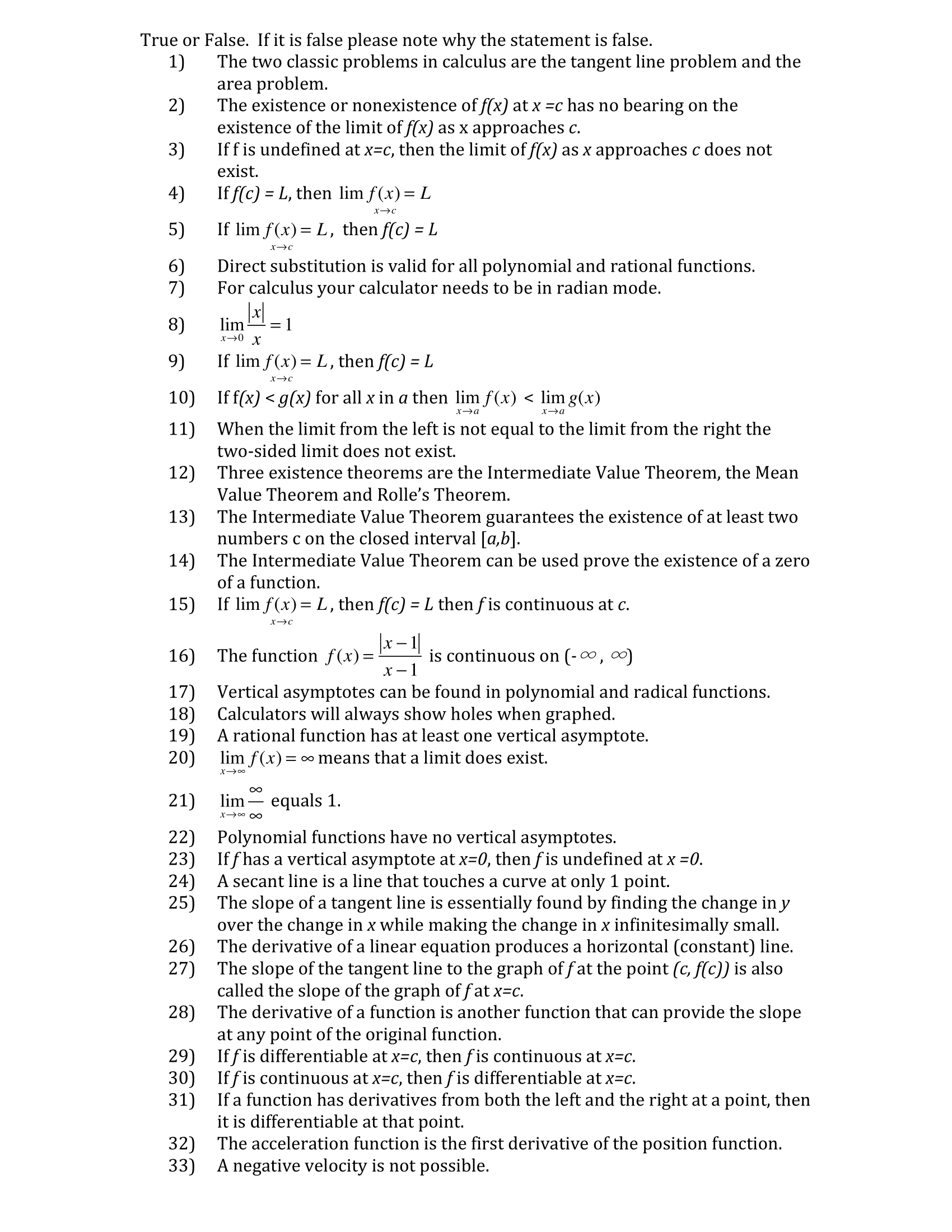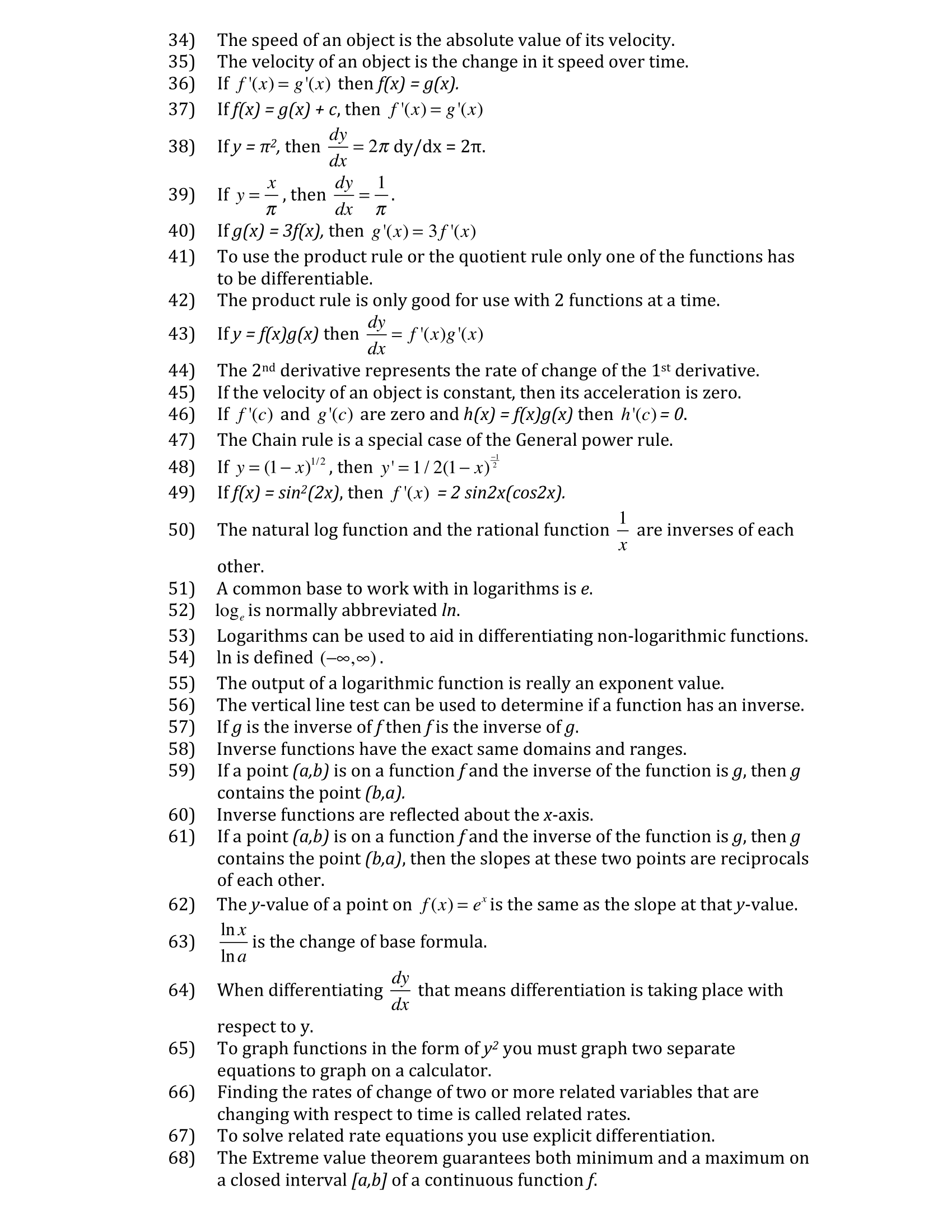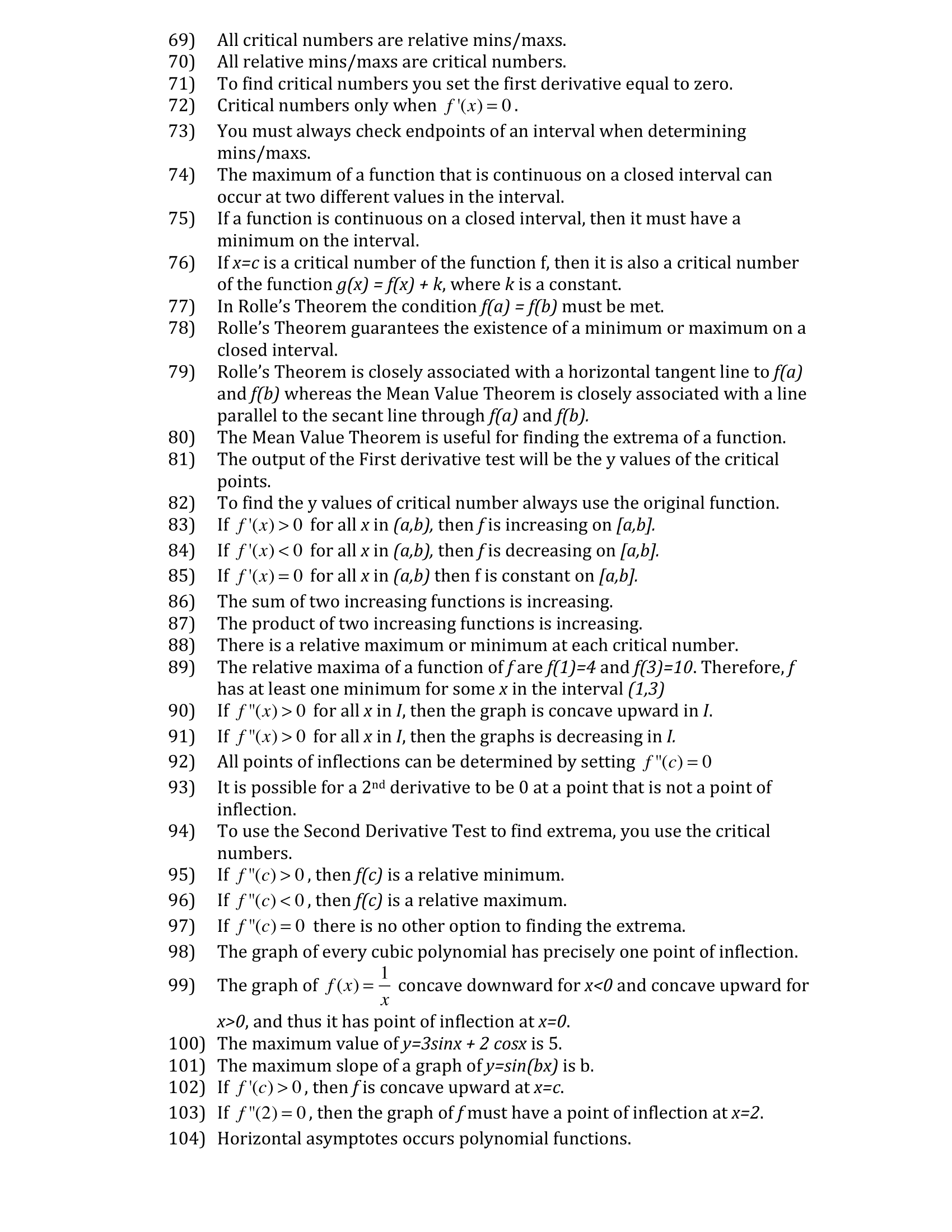Question:
True or False. If it is false please note why the statement is false. 1) 2) 3) 4) 5) 6) 7) 8) 9) 10] 11] 12] 13] 14] 15] 16] 17) 18] 19) 20] 21) 22] 23] 24) 25] 26] 27) 28] 29] 30] 31] 32] 33) The two classic problems in calculus are the tangent line problem and the area problem. The existence or nonexistence of x) atx =c has no bearing on the existence of the limit of f(X) as x approaches 6. If f is undefined at x=c, then the limit of f(x) as x approaches c does not exist. Iff(c) = L, then limf(x) : L X4)C If limf(x) = L, thenf(c) : L xc Direct substitution is valid for all polynomial and rational functions. For calculus your calculator needs to be in radian mode. limm = 1 x)0 x If limf(x)= L,thenf(c) =L X)C If f(x) xm When the limit from the left is not equal to the limit from the right the two-sided limit does not exist. Three existence theorems are the Intermediate Value Theorem, the Mean Value Theorem and Rolle's Theorem. The Intermediate Value Theorem guarantees the existence of at least two numbers c on the closed interval [(1,1)]. The Intermediate Value Theorem can be used prove the existence of a zero of a function. If limf(x) = L, thenf(c) = L thenfis continuous at c. I4)C 1 The function f (x) = |x l 1 is continuous on (- 00, 00) x _ Vertical asymptotes can be found in polynomial and radical functions. Calculators will always show holes when graphed. A rational function has at least one vertical asymptote. 1irnf(x) = oo means that a limit does exist. x>m lim: equals 1. 1)w oo Polynomial functions have no vertical asymptotes. If f has a vertical asymptote at x=0, then f is undefined at x =0. A secant line is a line that touches a curve at only 1 point. The slope of a tangent line is essentially found by nding the change in y over the change in x while making the change in x infinitesimally small. The derivative of a linear equation produces a horizontal (constant) line. The slope of the tangent line to the graph of f at the point (c, f[c)] is also called the slope of the graph of f at x=c. The derivative of a function is another function that can provide the slope at any point of the original function. If f is differentiable at x=c, then f is continuous at x=c. If f is continuous at x=c, then f is differentiable at x=c. If a function has derivatives from both the left and the right at a point, then it is differentiable at that point. The acceleration function is the first derivative of the position function. A negative velocity is not possible. 34) 35] 36] 37] 38) 39) 40] 41] 42] 43] 44) 45] 46) 47) 48] 49) 50] 51] 52) 53) 54] 55] 56] 57] 58) 59] 60] 61) 62] 63] 64] 65] 66] 67] 68) The speed of an object is the absolute value of its velocity. The velocity of an object is the change in it speed over time. If f '06) = g'OC) thenf[x) =9[X)- Iff(X) =90) + c. then f'(x) = gm Ify = 112, then % = 27: dy/dx = 211. 1 Ify=,then dy=. 1: dx 7:: Ifg(x) = 3f(x], then g'(x) = 3f'(x) To use the product rule or the quotient rule only one of the functions has to be differentiable. The product rule is only good for use with 2 functions at a time. d Ify =f(X)g(X) then 3y = 10mg '00 The 2nd derivative represents the rate of change of the 1st derivative. If the velocity of an object is constant, then its acceleration is zero. If f'(c) and g'(c) are zero and 1104) :f[x)g(x) then h'(c): 0. The Chain rule is a special case of the General power rule. If y: (lx)\"2,then y':1/2(1mx)'?' If f(x) : sin2[2x], then f '(x) z 2 sian[cost). . . . 1 . The natural log function and the rational function are inverses of each x other. A common base to work with in logarithms is e. log is normally abbreviated In. Logarithms can be used to aid in differentiating non-logarithmic functions. In is dened (oo,oo). The output of a logarithmic function is really an exponent value. The vertical line test can be used to determine if a function has an inverse. Ifg is the inverse offthenfis the inverse ofg. Inverse functions have the exact same domains and ranges. If a point {51,17} is on a function f and the inverse of the function is g, then 9 contains the point (ha). Inverse functions are reected about the xaxis. If a point (a,b] is on a function f and the inverse of the function is g, then 9 contains the point (ha), then the slopes at these two points are reciprocals of each other. The y-value of a point on f (x) = e" is the same as the slope at that y-value. 111xis the change of base formula. lna When differentiating % that means differentiation is taking place with respect to y. To graph functions in the form of y2 you must graph two separate equations to graph on a calculator. Finding the rates of change of two or more related variables that are changing with respect to time is called related rates. To solve related rate equations you use explicit differentiation. The Extreme value theorem guarantees both minimum and a maximum on a closed interval [(1,1)] of a continuous function f. 69] 70] 71) 72] 73] 74] 75] 76] 77] 78] 79] 80] 81] 82] 83] 84] 85] 86] 87) 88] 89) 90] 91] 92] 93] 94] 95] 96] 97) 98) 99) 100) 101) 102) 103) 104) All critical numbers are relative mins/maxs. All relative mins/maxs are critical numbers. To nd critical numbers you set the first derivative equal to zero. Critical numbers only when f '(x) = 0. You must always check endpoints of an interval when determining mins/maxs. The maximum of a function that is continuous on a closed interval can occur at two different values in the interval. If a function is continuous on a closed interval, then it must have a minimum on the interval. If x=c is a critical number of the function f, then it is also a critical number of the function g(x) :f(x) + k, where k is a constant. In Rolle's Theorem the condition f( a) =f(b) must be met. Rolle's Theorem guarantees the existence of a minimum or maximum on a closed interval. Rolle's Theorem is closely associated with a horizontal tangent line to u) and f( b) whereas the Mean Value Theorem is closely associated with a line parallel to the secant line through f[ a] and f(b). The Mean Value Theorem is useful for nding the extrema of a function. The output of the First derivative test will be the y values of the critical points. To nd the y values of critical number always use the original function. If f'(x) > 0 for all x in [(112), thenfis increasing on [a,b]. If f'(x) 0 for all x in I, then the graph is concave upward in I. If f "(x) > 0 for all x in I, then the graphs is decreasing in I. All points of inections can be determined by setting f "(0) = 0 It is possible for a 2nd derivative to be 0 at a point that is not a point of inection. To use the Second Derivative Test to find extrema, you use the critical numbers. If f "(c) > 0, then f(c) is a relative minimum. If f 1'(c) 0, and thus it has point of inection at x=0. The maximum value of y:3sinx + 2 cosx is 5. The maximum slope of a graph of y=sin[bx] is b. If f '(c) > 0, then f is concave upward at xzc. If f "(2) = 0, then the graph of f must have a point of inection at x=2. Horizontal asymptotes occurs polynomial functions









